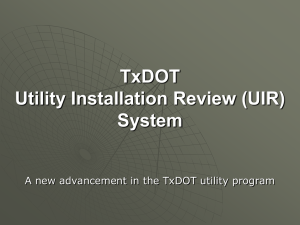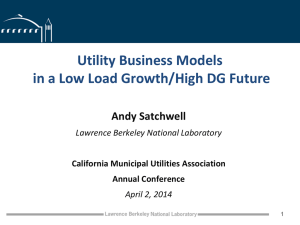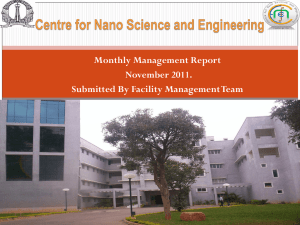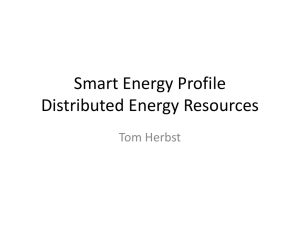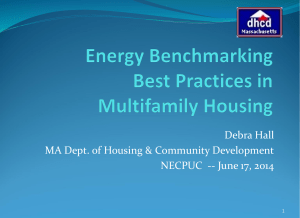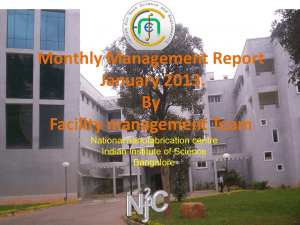Ratemaking Explained - Public Utility Commission
advertisement
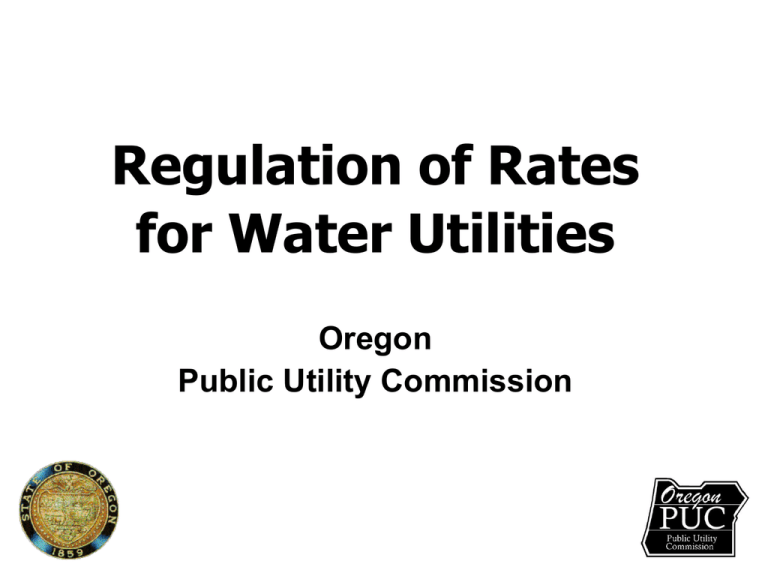
Regulation of Rates for Water Utilities Oregon Public Utility Commission Oregon Public Utility Commission Telephone Power Natural Gas Water 2 Public Utility Commission The Commission is charged with the duty to ensure safe and adequate water service at fair and reasonable rates. The Commission is chartered as a consumer protection and advocacy body. It is responsible to protect the customers of any public utility, and the public generally, from unjust and unreasonable exactions and practices, and to obtain for them adequate service at fair and reasonable rates. The Commission balances the interests of the utility investor and the consumer in establishing fair and reasonable rates. Rates set by the Commission are sufficient to ensure confidence in the financial integrity of the utility, allowing the utility to maintain its credit and attract capital. The utility should be allowed to earn sufficient revenues for reasons of debt service and capital for reinvestment. PUC STATUTORY AUTHORITY ° ORS 756.070 – 125 INVESTIGATORY POWERS ° ORS 756.160 – 200 ENFORCEMENT & REMEDIES ° ORS 757.005 DEFINES A PUBLIC UTILITY ° ORS 757.020 DUTY TO SERVE ° ORS 757.061 REGULATION OF WATER UTILITIES 3 Public Utility Commission PUC Authority Regulate Rates Regulate Service Regulatory Obligation Protect Customers Protect Utility 4 Rate Case Filing Utility Files Application Brief - summary of application Direct Testimony - details of application Tariffs include: Rate schedules Rules & regulations 5 Flowchart - Water Rate Case 1. UTILITY FILING Utility files application direct testimony, and tariffs to PUC 2. NOTIFICATION Within 15 days of filing, utility notifies customers by an article in the newspaper or direct customer mailing 5. PREHEARING CONFERENCE Adopt schedule Receive petitions to intervene Establish issues Identify Parties Create service list 6. DISCOVERY Data Requests Data Responses SUSPENSION 4. OPEN HOUSE Public comments taken Written comments may be submitted to the Administrative Law Judge If Necessary 10. EVIDENTIARY HEARING 3. TARIFF Commission orders tariffs suspended to allow time to review the utility’s proposal 9. REBUTTAL TESTIMONY Enter pre-filed testimony into record Cross-examination of witnesses Identify issues to be briefed ALJ briefing instructions 7. SETTLEMENT CONFERENCE Staff presents its Preliminary Results of Analysis to utility & intervenors who attempt to reach agreement on as many issues as possible 8. WRITTEN TESTIMONY Staff & intervenors responding to utility’s direct testimony 11. WRITTEN BRIEFS Briefs are submitted if requested by the ALJ 12. COMMISSION DECISION Commission issues order establishing new rates 6 Customer Notification Within 15 days of utility filing Utility must provide customer notification Newspaper article Direct mailing To receive copy of filing, call the utility 7 Suspension of Tariffs PUC 30-Day Response to Filing Approve Disapprove Suspend tariffs Generally request a 6-month suspension – allows investigation of rate proposal 8 Open House Opportunity to Communicate Customer Concerns Voice Opinion Comments to Staff or Consumer Services Phone Written by mail or fax E-filed to PUC Filing Center 9 Consumer Services 1-800-522-2404 Public Utility Commission Consumer Services Division P.O. Box 1088 Salem OR 97308-1088 puc.filingcenter @state.or.us 10 Prehearing Conference Purpose 1) 2) 3) 4) 5) Petition to intervene Identify parties Create a service list Establish issues Adopt schedule 11 Who are the Players? How to Participate Public & Interested Persons Utility - Party Interveners - Party PUC Staff - Party Assistant Attorney General Administrative Law Judge Commission 12 Discovery Period Information Exchange Burden of Proof Gather Information Data Requests Data Responses Develop Position Verify Facts Revenues Expenses Utility Plant Service Issues Other Issues 13 Settlement Conference Staff presents its settlement case Only parties may participate Customers may attend Parties attempt to reach agreement Stipulation Partial stipulation Contested case 14 Testimony Written Testimony Filed Stating the Party’s Position Staff testimony Intervener testimony Rebuttal Testimony (if necessary) 15 Evidentiary Hearing Contested Case ALJ Presides Testimony entered into the record Cross-examination of witnesses Briefs, identify issues if requested 16 ALJ Drafts Order & Recommendation ALJ reviews evidence in the record ALJ writes draft order & makes recommendation to Commission 17 Commission Decision Issues Order Disposing the Rate Case Establishes New Rates Sets Effective Date of New Rates Resolution of Outstanding Issues Petition for Reconsideration If warranted, Commission will review 18 Rate Regulation Allows company to recover its prudent and reasonable cost of service Gives company an opportunity for a reasonable return on its investment Establishes rates through rate cases 19 Ratemaking Formula R = E+(v-d)r Revenues (Revenue Requirement) Expenses value of rate base plant depreciation rate of return 20 Summary: Determining Rates Under the Rate of Return Regulation Methodology 1. DETERMINE REVENUE REQUIREMENT The revenue requirement is the amount of annual revenue necessary to recover the annual cost of providing service and provide an opportunity for the utility to earn a reasonable return on its investment. The revenue requirement is based upon the formula: R = E + (V-d) r R represents revenue requirement. It is the amount of revenue required to generate a desired return on investment given a specified level of operating expenses and rate base. E represents expense. This is the reasonable annual expense the utility incurs to provide utility service (also called the cost of service). (V-d) represents the value of the utility's capital investment less its accumulated depreciation (and other required adjustments) necessary to calculate the utility's net plant in service. Working cash and materials and supplies inventory adjustments are then added to the net plant resulting in the utility's capital investment, called rate base. r represents the rate of return that is achieved by adding the weighted cost of debt and the weighted cost of equity. The rate of return is then applied to the utility's rate base to produce a return on the utility's investment. The resulting amount is then included in the revenue requirement. 21 Determining Rates (continued) 2. RATE SPREAD Rate spread is the allocation of the revenue requirement to the various classes of customers (residential, commercial, etc.). Customers with common characteristics are grouped into customer classes. If it is possible to determine the costs associated with the different customer classes, the costs should be allocated to the customer class that incurs the cost. 3. RATE DESIGN Rate design is the determination of the rate or price structure for each customer class. The revenue requirement has already been determined and divided among the different customer classes. Now the customer service rate must be designed to provide for the recovery of the allocated revenue requirement within each class. There are several different types of rate structures that can be used. Rate design is to determine the most appropriate rate structure for each customer class. 22 Water Program Staff Kathy Willis Sr. Utility Analyst (503) 373-1003 kathy.willis@state.or.us Greg Miller Financial Analyst (503) 373-7867 greg.miller@state.or.us Celeste Hari Utility Analyst (503-378-6628 celeste.hari@state.or.us 23

